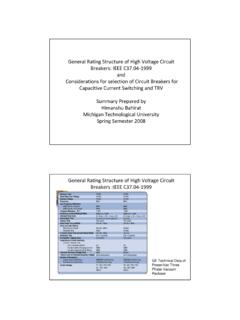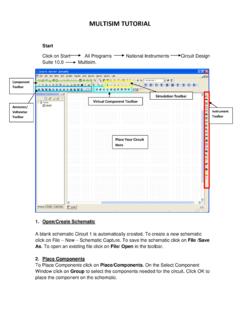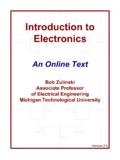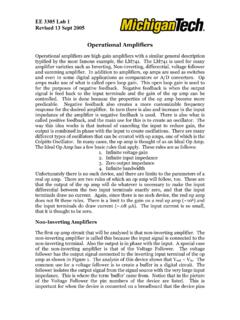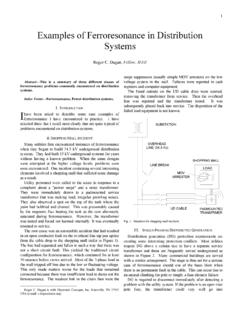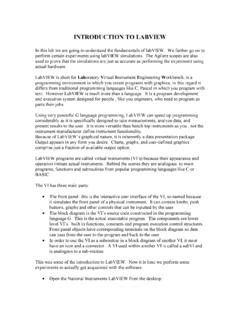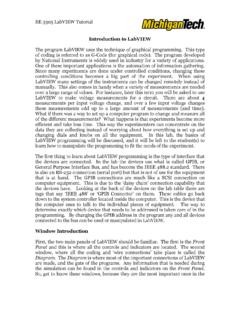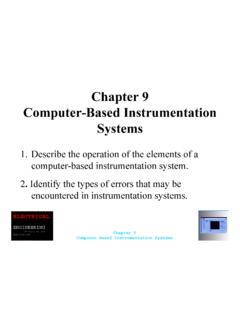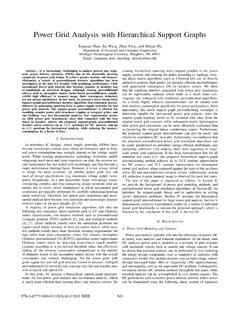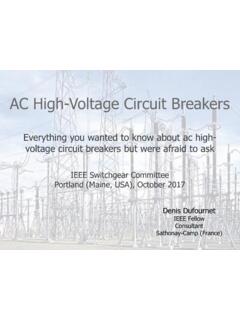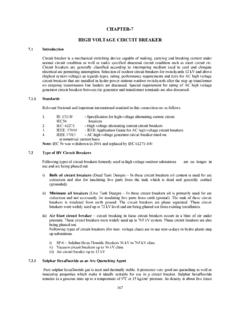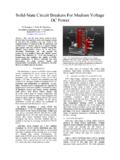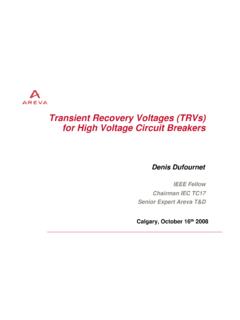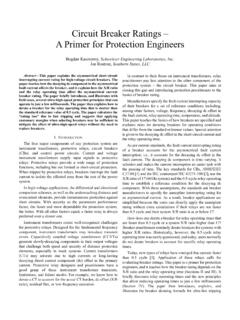Transcription of Effects of Transient Recovery Voltages on Circuit Breaker ...
1 Effects of Transient Recovery Voltages on Circuit Breaker Ratings Term Project: - EE5220 - Power System Transients. Spring 2008 Instructor: - Dr. Bruce Mork Team: - Himanshu Bahirat Muhammad Ali Praveen KK Effects of Transient Recovery Voltages on Circuit Breaker Ratings Table of Contents .. 4 Recovery Voltages on Systems .. 4 What is Transient Recovery voltage ? Factors affecting Transient Recovery voltage Types Transient Recovery voltage waveshapes of Transient Recovery Voltages on Systems .. 5 System reduction Calculation of different Types Transient Recovery voltage waveshapes Breaker Ratings Structure .. 8 General Rating Structure Ratings important for TRV of Transient Recovery Voltages on Circuit Breaker .
2 9 Insulation Failures Re-ignition and Re-strikes of Transient Recovery Voltages of Circuit Breaker .. 10 Envelope Specification and Calculation Factors affecting Transient Recovery voltage Fault Currents Circuit Parameters Out-of-phase Switching First Pole to Clear Factors Applications Study for analysis of TRV and Circuit Breaker Ratings Selection .. 14 Modeling for ATP from single line diagram Simulation in ATP Study of TRV obtained at various locations Interpretation of results of simulation TRV values obtained by simulation Ratings of Circuit breakers as per standards Comparison of ratings and values from simulation .. 18 .. 19 .. 19.
3 20 1. Introduction Transient is associated with every change of state of a Circuit . Transient Recovery voltage thus is the Transient across a Circuit Breaker . Transient Recovery Voltages are contingent upon the Circuit conditions and parameters of the Circuit . Thus making it extremely essential to study them for application of Circuit breakers. [1][2][3] Generally, Circuit breakers in a system are applied based on available short Circuit capability at that point in the Circuit . But, when Circuit is interrupted it results in a TRV, this has deleterious Effects on the Circuit Breaker . TRV manifests in different way depending on Circuit configuration, hence the object of this report is to study the various parameters causing and affecting the TRV.
4 2. Transient Recovery Voltages on Systems What is Transient Recovery voltage ?[1][2] It is ascertained that TRV is resultant of the change in state of Circuit . Thus TRV can be defined as voltage appearing across a Circuit Breaker after a switching action. Typical of every Transient TRV also has high amplitude and high frequency. The figure below shows example of TRV, figure is taken from TRV explanation given by Dufornet et. al.[1][2] Figure-1:- Transient Recovery voltage [2] TRV is a point by point difference of voltage at the incoming side and at the outgoing side of a Circuit Breaker . When a Circuit Breaker interrupts, incoming side or the side to bus or supply is connected tries to return to power frequency voltage level and the outgoing side depending on what is connected also oscillates.
5 The difference between these Voltages is Recovery voltage . TRV is associated with every interruption, but the ones resulting because of interruption of fault current are the most ominous TRV. Thus the choice of Circuit breakers or introduction of means and methods for safeguarding the Circuit and Circuit Breaker has to be considered. Factors affecting TRV [1][2][5] Transient Recovery voltage is affected by various parameters of the system. Prominent among them are listed below:- 1. Inductance and capacitance in the system 2. Fault current level of the system at point of study of TRV. 3. Bushing capacitance of Circuit breakers, voltage transformers etc 4. Number of transmission lines terminating at a bus and their characteristics impedance.
6 5. Internal factors of the Circuit Breaker like the first pole to clear a fault etc. 6. System grounding. Types of TRV wave shapes [2][5] Transient Recovery Voltages manifesting across any Circuit Breaker in a system are seen to have some typical shapes. Waveshapes are classified into types[2]: 1. 1- Cosine: Observed in case of transformer fed or reactor fed faults. 2. Exponential cosine: Observed when transformer fed faults on Breaker terminals with transmission lines connected on the incoming side of Circuit Breaker . 3. Triangular or Saw-tooth waveshape : Observed on line side when short transmission lines are connected. 4. Initial TRV: Observed when buswork of substation is involved. Figure 2a:-1-Cosine TRV [2] Figure 2 b.
7 Exponential TRV [2] TRV [2] 3. Calculation of different types of TRV wave shapes System Reduction [1][2] TRV can be analyzed by drawing detailed system diagram and then reducing it to obtain an equivalent Circuit across the Breaker terminals. It is generally observed that system can be reduced to a series or parallel R-L-C circuits. These equivalent RLC Circuit can then be solved for TRV. An example of Circuit reduction is shown below. The system is first drawn out as single line diagram and afterwards single phase RLC parallel equivalent is obtained at the Breaker terminals. To obtain the resultant TRV it is assumed to inject short Circuit current in the Breaker terminals and solution for voltage across the elements is obtained which is TRV.
8 Figure 3a :-Single Line Diagram[2] Figure 3c :-Equivalent RLC Network[2] Figure 3b :-Three phase Diagram[2] Calculation of different types Transient Recovery voltage waveshapes 1-Cosine or Oscillatory or Underdamped TRV [2] This waveshape is generally obtained in case of transformer or reactor fed faults. This kind of TRV waveshape can also be obtained with transformer fed fault on a bus with with small number of transmission lines connected to it. System to be used for analysis of this kind is shown figure- 3. The resultant equations after analysis are shown below.[2] (3) oscillator be toTRVfor Condition -(2)----- KV cos1 toreduces neglected, is 3c figure of resistance lines, no are thereIf-(1)--- KV sinhcosh111eqeqeqeqeqCBtCBCLZCLtEVtteEV = + = faradsin ecapacitanc equivalent Henrysin inductance equivalent ohmsin impedance equivalent 121frequency System2 -breakercircuit open across voltage 21eqeqeqeqeqeqeqeqCBCLZCLCZLIEV where Exponential TRV [2] This waveshape is obtained, when a Circuit Breaker at a bus with large number of transmission lines, interrupts a faults at its terminals.
9 The waveshape obtained is seen on the bus side of the Circuit Breaker .. This is also referred to as overdamped TRV. The system used for analysis is the same as shown figure3a. [2] (5) lexponentia be toTRVfor Condition -(4)--- KV 1 toreduces (1) eq. and neglected iscircuit of e capacitanc thehence line, theof impedance surge iscircuit equivalentin resistance systemsmany For 1eqeqeqeqeqtCBCLZsZLeEV = Triangular or Sawtooth Waveshape [2] When a fault at a short distance from the Circuit Breaker on the transmission line is interrupted it results in triangular TRV on line side of Circuit Breaker . Sawtooth TRV is characterized by high rate of rise of Recovery voltage (RRRV). These are seen to damage Circuit breakers because of high RRRV even thought the peak of TRV is less.
10 The analysis of this TRV is based on the traveling wave on transmission lines.[2] (KV) voltagemaximum rated currentcircuit short rated current tofault of ratio line of impedance Surge CurrentFault 2peak to time---- side sourceon TRV ofdelay time)8()(2)7(32)1(-(6)---by given isbreaker Circuit across TRVmaxmaxEMZIZIRRVT twheretTMVEMdVVVVLLLLLLddLSLSLCB == = =+= 4. Circuit Breaker Ratings Structure IEEE defines a general rating structure for high voltage Circuit breakers 1000 V AC and above. The rating structure comprises of indoor and outdoor Circuit breakers. ANSI/IEEE states preferred rating for the Circuit breakers. Ratings structure establishes the basis for rating s to be assigned to Circuit breakers including electrical and mechanical characteristics.
